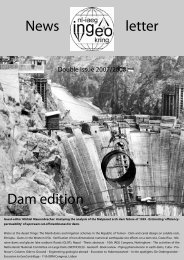environment
environment
environment
- No tags were found...
You also want an ePaper? Increase the reach of your titles
YUMPU automatically turns print PDFs into web optimized ePapers that Google loves.
Vol. 11 No. 1 2004<br />
Cutting of trees is kept to a minimum and only within<br />
the road corridor. The previously used bulldozers are<br />
now replaced by excavators, which allows for the<br />
loading of tippers and the transport of excavated surplus<br />
material and debris to selected spoil disposal sites (see<br />
figure 2). Excavated materials are now also segregated<br />
in order to optimise re-use. Excavation is done in benches<br />
starting from the top batter by the smaller excavator<br />
and subsequently excavation to the final level by the<br />
medium sized excavator.<br />
Barriers constructed out of logs or boulders at about<br />
10-15 meter below the road are used to catch materials<br />
falling down or in some cases to allow for controlled<br />
dumping of excavated materials. Trenches, excavated<br />
by excavator, are also used for this purpose. These<br />
features are especially important to protect the valley<br />
side vegetation and to create spoil disposals near the<br />
excavation site. The latter is important since transport<br />
of excavated materials is relatively expensive.<br />
figure 4: cross drainage<br />
forest cover, soil classification, slope steepness, water<br />
sources, cultural heritage, and other factors. For this<br />
purpose, survey teams have been trained to collect<br />
information and make assessments. By building the<br />
roads away from geologically-hazardous and culturallyvulnerable<br />
areas, many problems can be avoided in the<br />
later stages of construction and it extends the life of the<br />
road. The design engineer needs therefore to find the<br />
optimal balance in the design between prevention of<br />
<strong>environment</strong>al damage and investment and maintenance<br />
costs over the life-time of the road.<br />
Controlled blasting is adopted in order to minimize<br />
damages to the down hill <strong>environment</strong> and to prevent<br />
destabilization of the remaining slopes (see figure 3).<br />
Marshy areas are drained before excavation is allowed<br />
through the construction of French drains and other<br />
water management structures such as catch drains.<br />
Permanent structures and the base course are now taken<br />
up with the formation-cutting works in one contract.<br />
This provides an incentive for the contractor to ensure<br />
that excavated useful materials like boulders are kept<br />
aside and are used in the permanent works. It also<br />
ensures that proper water drainage is available already<br />
during the first monsoon, which decreases the risk of<br />
erosion and landslides (see figure 4). A new design for<br />
retaining walls, with gabion boxes, has been introduced.<br />
These walls are permeable and are flexible enough to<br />
adapt to small slope movements.<br />
The right balance<br />
Environmental friendly design aims to minimize where<br />
possible cuts into mountain slopes. Especially where<br />
the slopes are fragile and prone to landslides, part of<br />
the road width will be made in fill, so retaining walls are<br />
necessary. Box cut designs are avoided in order to reduce<br />
the volume of cut and the height of cut. Based on<br />
experiences from executed projects, it is estimated that<br />
the volume of cut decreases by roughly 4 times if box<br />
cuts are avoided in the design. It is also estimated that<br />
by shifting the road centre line to the valley side by 1<br />
meter, a reduction of cut volume by 35 % and a shift by<br />
2 meters a reduction of cut volume by 65% can be<br />
achieved. The design engineers must find a balance<br />
between less cutting in the slopes and higher initial<br />
investments for retaining walls.<br />
figure 5: bio-engineering<br />
27




